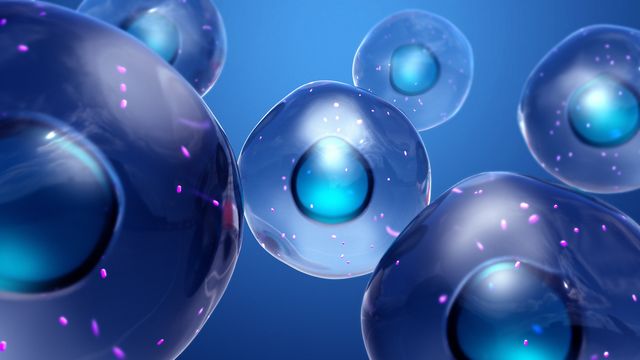Researchers have developed a tiny sensor capable of detecting protein biomarkers at single-molecule precision. The sensor works by using a protein binder that fuses to a nanopore, a small hole created in the membrane of a cell. When the sensor recognizes a targeted molecule, the ionic flow changes, indicating that the biomarker has been found. The sensor is equipped with hooks that quickly and accurately fish protein biomarkers from a solution, enabling better identification and quantification of protein biomarkers associated with various malignancies and tumors.
The team tested their hypothesis using a blood serum sample and were able to identify and quantify epidermal growth factor receptor (EGFR), a protein biomarker in various cancers. The project paves the way for broad applications in biomarker detection in complex biofluids. By integrating the sensors into nanofluidic devices, this technology would allow scientists to test for many different biomarkers at once in a specimen, providing a fundamental basis for biomarker detection in complex biofluids. The ability to detect protein biomarkers at single-molecule precision will provide healthcare professionals with more accurate and reliable data, enabling them to diagnose diseases earlier and more effectively.
A team of researchers has developed a nano-sized sensor capable of detecting protein biomarkers in a sample with single-molecule precision. Biomarkers are molecules that are used in healthcare to signal the presence of diseases such as cancer. The tiny sensor works by using a protein binder that fuses to a nanopore, a small hole created in the membrane of a cell, allowing an ionic solution to flow through it. When the sensor recognizes a targeted molecule, the ionic flow changes, indicating that the biomarker has been found. The sensor is equipped with hooks that quickly and accurately fish protein biomarkers from a solution, which enables better identification and quantification of protein biomarkers associated with various hematological malignancies and solid tumors.
The team of researchers from Syracuse University’s College of Arts and Sciences (A&S), SUNY Upstate Medical University, Ichor Therapeutics, and Clarkson University formulated a sensor design architecture that can be applied to a wide range of protein targets. Their latest research, published in Nature Communications, addresses previous challenges that existed in making this technology generalizable.
This innovative technology could revolutionize the healthcare industry by allowing for the early detection and monitoring of diseases. The ability to detect protein biomarkers at single-molecule precision will provide healthcare professionals with more accurate and reliable data, enabling them to diagnose diseases earlier and more effectively. This nano-sized sensor technology is a significant breakthrough in healthcare and could potentially save many lives in the future.
The team of researchers behind the development of a nano-sized sensor capable of detecting protein biomarkers at single-molecule precision has taken a significant step forward in the healthcare industry. The researchers combined nanopore technology with antibody mimetic technology, which are artificially designed protein scaffolds that behave like antibodies and bind and interact with a specific biomarker. These antibody mimetics are created using established scaffolds from nature and are adapted through evolutionary mutagenesis, where billions of DNA mutations are scanned until the scientists find some that interact strongly with a specific protein.
The sensor developed by the team is highly specific and can detect a targeted protein with no false positives, making it practical for biomedical diagnostics. The sensor works by having a protein binder that fuses to a nanopore in the membrane of a cell. When the sensor recognizes a targeted molecule, the ionic flow changes, indicating that the biomarker has been found. The sensor is equipped with hooks that quickly and accurately fish protein biomarkers from a solution, which enables better identification and quantification of protein biomarkers associated with various hematological malignancies and solid tumors.
To validate their findings, the team tested their hypothesis using a blood serum sample. With their technology, they were able to identify and quantify epidermal growth factor receptor (EGFR), a protein biomarker in various cancers. This technology could revolutionize the healthcare industry by allowing for the early detection and monitoring of diseases. The ability to detect protein biomarkers at single-molecule precision will provide healthcare professionals with more accurate and reliable data, enabling them to diagnose diseases earlier and more effectively.
The project paves the way for broad applications in biomarker detection in complex biofluids. For example, by integrating the sensors into nanofluidic devices, this technology would allow scientists to test for many different biomarkers at once in a specimen, providing a fundamental basis for biomarker detection in complex biofluids. According to Liviu Movileanu, one of the researchers on the project, “The future of medicine won’t rely as much on imaging and biopsies when diagnosing cancers…Instead, researchers will use nano-sensor technology, like what we are developing in our lab, to test blood samples for the presence of various biomarkers associated with different cancers. This research is critical to the future of prognostics, diagnostics and therapeutics.”
The team’s latest research, published in Nature Communications, provides a concept prototype and addresses previous challenges that existed in making this technology generalizable. The project was supported by a $1.2 million grant from the National Institutes of Health.
The article has been adapted from materials published on the Syracuse University College of Arts and Sciences website. The content may have been edited for length and clarity, and readers can refer to the cited source for more information.
Don’t miss interesting posts on Famousbio
